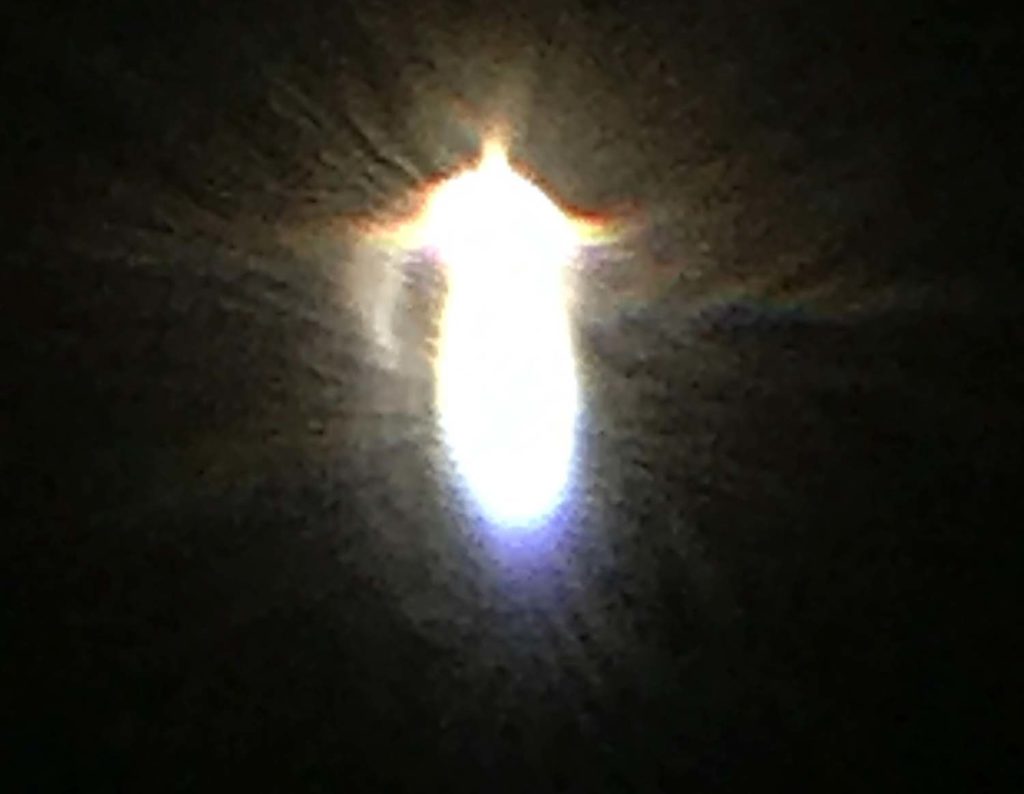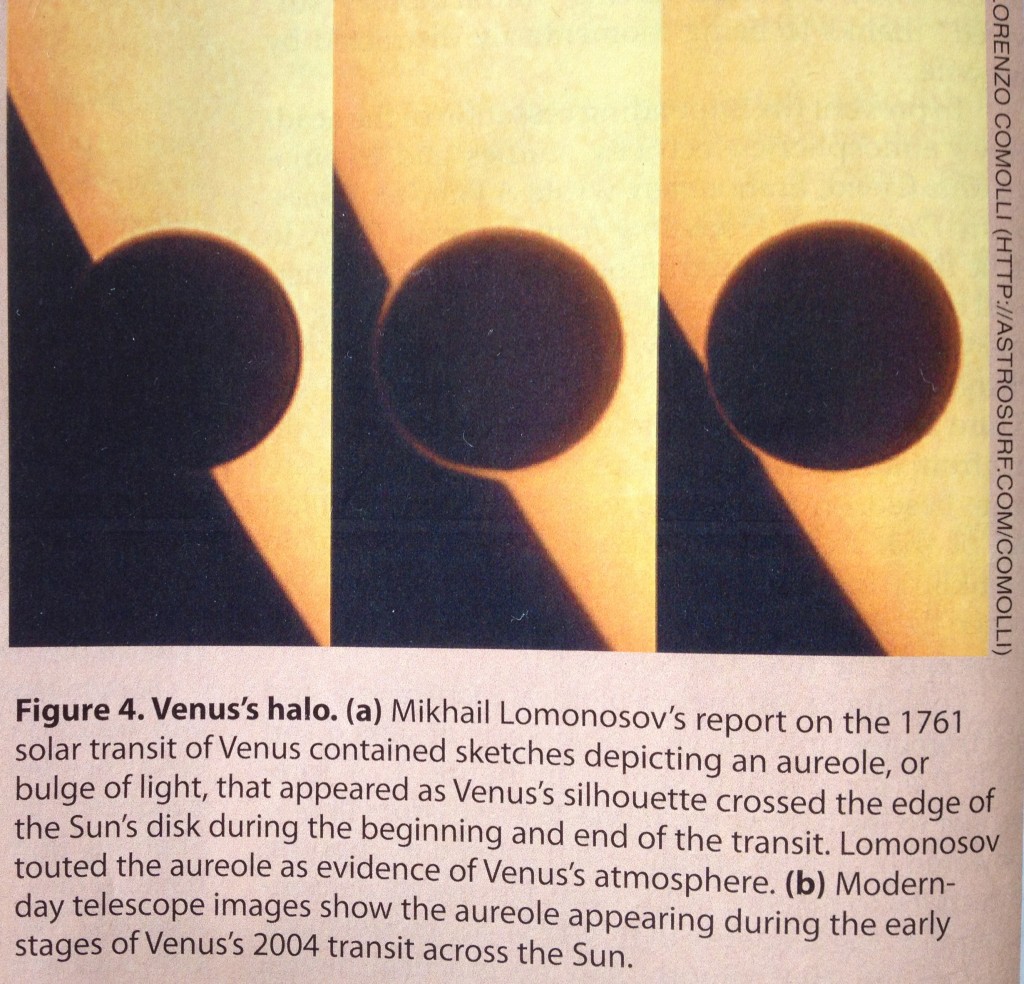Eclipse photography can call for specialized equipment, both for the hours of partial coverage before and after, and for the few short minutes of totality. A Poor Man’s Pinhole Mirror can avoid some of those equipment issues, and allow for relatively safe viewing. I do not know all the safe limits for Eclipse watching (except of course the use of ISO rated Eclipse Viewing Glasses) apart from my Darwinian sense which says “DO NOT LOOK AT VERY BRIGHT IMAGES”. This skill has kept my eyeballs intact for 84 years, despite attending two other Solar Eclipses, plus searching marine sunset horizons many, many times (with only one success – I had to sail to mid-Atlantic for that) seeking the ever-elusive Green Flash. An interesting side note on Eyeballs: As I aged I began to need reading glasses, and distance glasses for driving. Then, when having further aged I started taking recommended “areds2 PreserVision®” vitamin E pills nearly a year ago. My distance vision has now improved to where my new driver’s license tested me last week as OK for no glasses: “Unrestricted”. Don’t know if it’s the years or the pills but I’m happy to play tennis again without glasses.
Back on May 10th, 1994, an annular solar eclipse was visible in Toledo, OH. Using a pinhole in a card only makes a small image when held by hand. With the sun overhead covering about a 0.5 degree angle you get an image about half an inch in diameter on a white paper screen on the ground when you hold a pinhole card overhead. Even using a small telescope or half of a pair of binoculars you still have to align them with the direction of the sun and only get a somewhat larger image.
I had the idea then, which must surely have been thought of many times before, to get more distance from pinhole to screen by putting my pinhole on a front surface mirror and tilting it to project the image deep into a darkened room. This easily made set-up allows everyone to watch a larger, and fainter, image of the full process in relative safety.
On that day in 1994 I shone a reflected beam from a half inch dia. pinhole through an open door, deep (nearly 150 ft.) into a darkened warehouse and obtained a large image, about 15 inch dia., on a white paper flip-chart, of the partially eclipsed sun. I tried to trace the outline of the sun and the moon on the flip-chart but by the time my pencil got around and back to the starting point the image was moved by the Earth’s rotation and the line failed to join up. Somewhere the paper exists from that Eureka moment, but its exact location escapes me right now.
Some call the Pinhole Mirror a “Pinhead Mirror” but I feel the ‘head’ in that name implies the slightly domed or convex shiny top of a typical head of a pin and that would not create a focused image. So for now I’ll refer to the apparatus as “Pinhole Mirror”.
The key to successful Pinhole Mirror usage is to have a “Front Surface Mirror” on a ‘flat’ piece of glass. The flattest glass readily available is ordinary 6 mm (1/4”) thick. 6 mm float glass. It is so extraordinarily flat it can even give unwanted optical interference patterns if not properly used. Float glass is made by pouring molten glass onto hot, liquid tin. Under gravity the less dense glass spreads out, while the attractive force of surface tension tries to retain it as a large drop. On planet Earth the two forces come to equilibrium at a glass thickness of 6 mm. Passing down to a cooler section of the float bath the glass solidifies and the stiff and strong material can be lifted off the still molten tin. Strictly speaking the glass is not mathematically ‘flat’ but theoretically is a constant thickness hollow spherical section corresponding to the curvature of the Earth’s surface!
The use of a ‘front surface’ reflective coating avoids the multiple faint, out of register, images which would occur with a regular domestic mirror when the glass/air interface (at the opposite side to the silvered surface) also gives its 4% reflection.
Pilkington/NSG Mirropane® has a hard metallic reflective coating of nearly 70% and is an excellent material for Pinhole Mirrors. A small sample is all you need, provided you know someone in the glass business! A higher reflection of around 90% can be had by simply dissolving the protective paint and copper backing off a regular silvered commercial mirror: apply a pad soaked in Acetone for a few tens of minutes. The exposed silver is delicate and will eventually oxidize but it will be good for many days observation during an eclipse event.
After the 1994 Annular Eclipse I used a Pinhole Mirror to track the Transit of Venus on June 18, 2012. The same principles applied but I did not have access to a darkened room so the image below is only barely shows the silhouette of the Venus, between streaks of thin cloud. (see the small dark spot in the top right quadrant)\
The total Solar Eclipse of 21 August, 2017 was viewed from a public park in Bowling Green, KY.
The pinholes in my straw hat created many tiny images:
A handheld front surface Pinhole Mirror gave this small image of the progressing eclipse onto a white card, from a few feet away, in daylight. (No darkened room was available for better projection)
Meanwhile in Brooklyn NY, John Muggenborg, NYT Architecture Photographer, watched a partial solar coverage on the same day. He came up with the idea of leaving his pinhole mirror fixed in modelling clay over 100 ft away while he moved his screen, at the bottom of a dark shading box, to follow the slow moving image to the great delight of many:
Meanwhile Keith and Aya, in Vancouver, BC, used a similar pinhole mirror beaming an image into a screen in their darkened apartment:
During totality in KY a quick shot with an unfiltered zoom lens on a digital camera dangerously just caught some of the solar corona as the full coverage ended:
Setting up for the coming April 8, 2024 event I have obtained an old scrapped movie camera tripod with pan and tilt screw adjustment. The 2 inch square guide star mirror is on the right side of the pin hole mirror. The pinhole size is adjustable by simply changing the circular disc mask size:
The adjustable tripod is very helpful as continuous fine tuning of the mirror aim is needed to counter the Earth’s rotation when projecting over a larger distance. When the distance of mirror to screen is increased the image moves more rapidly, crossing my screen in just a few minutes when the mirror is 150 ft. away. Ideally having someone to continually adjust the mirror angles gives more image observing and recording time. Projecting a long beam into a small window will need frequent resetting. Adding a second 2” square mirror, slightly out of plane with the Pinhole Mirror, provides a bright, but fuzzy, guide-star image which can easily be seen in outdoor sunlight. A target spot is chosen for this image corresponding to the aim of the much fainter, but sharper PH image in the dark room.
The optics of a fine beam over a long distance reveal other interesting phenomena:
First, the entry to the dark room cannot be through an old glass window. Even single thick, and reasonably flat 3 mm sheet glass readily shows many otherwise invisible distortions from miniscule thickness variations:
Smaller lights of slightly thinner 2 mm sheet glass gave other interestingly different patterns:
A portable slide viewing screen gives the best imaging when the reflected solar beam shines through and open window or door.
Another surprising effect is the visible extent of heat waves (shimmer?) when the light beam travels over a sunlight asphalt pavement. Viewing the sun with a 19 mm (3/4”) dia. pinhole mirror at 150 ft. distance over grass still gives some shimmer on a cold, 38 F, windy day. That suggests the problem is the 30 F (17C) air temperature difference across the open door or window.
Reminds me of an engineering job I once applied for on the CFHT telescope on Mauna Kea where the engineer’s job was to keep the HVAC running to cool the instrument by day so there would be no temperature difference when the dome was opened at night.
Fine tuning my pinhole mirror apparatus will hopefully achieve a sharp enough image to allow sun spots to be observed. I don’t expect it to resolve the solar corona during the eclipse but one can always hope?
Chris Barry
ChrisBarryG@Gmail.com
2024/04/05












 Even 6 mm laminated float glass will have a few slight distortions, plus it will incur the risk of multiple reflected images if the light shines through at an angle:
Even 6 mm laminated float glass will have a few slight distortions, plus it will incur the risk of multiple reflected images if the light shines through at an angle:



















